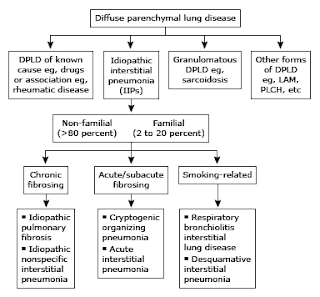Pulmonary fibrosis, or idiopathic interstitial lung disease, is challenging to manage in the hospital, largely because of the alphabet soup naming system, the constantly shifting classification system, overlapping diagnostic criteria, and the lack of effective therapies. Below, I try to simplify these diseases by focusing less on diagnostic criteria and more on therapies. As you'll see, we generally use steroids, with only expert opinion to guide us.
The below diagram places pulmonary fibrosis and idiopathic interstitial pneumonias in context with other noninfective diffuse lung diseases.
IIP: idiopathic interstitial pneumonia; LAM:
lymphangioleiomyomatosis; PLCH: pulmonary Langerhans cell
histiocytosis/histiocytosis X.
FDiagnosis is driven by high resolution CT. Treatments for Idiopathic Interstitial Pneumonias are largely based on expert opinion.
Idiopathic pulmonary fibrosis:
Most common, it's a chronic progressive disease with flares, median survival 2-3 years.
Acute presentation/flare: treat underlying cause, can try steroids (not studied)
Chronic: Nintedanib (tyrosine kinase inhibitor to block fibrosis), lung transplant.
Idiopathic nonspecific interstitial pneumonia:Less common, usually associated with connective tissue diseases or toxic exposures, when alone it is classified as “idiopathic.” Disease course is chronic progression with waxing and waning.
Chronic: Nintedanib (tyrosine kinase inhibitor to block fibrosis), lung transplant.
Idiopathic nonspecific interstitial pneumonia:Less common, usually associated with connective tissue diseases or toxic exposures, when alone it is classified as “idiopathic.” Disease course is chronic progression with waxing and waning.
Acute presentation/flare: High dose steroids (weakly studied)
Chronic: Treat underlying disease, add steroids, then add immunosuppressants
Chronic: Treat underlying disease, add steroids, then add immunosuppressants
Cryptogenic organizing pneumonia:Less common, can have single onset and resolve, or waxe and wane. Can be fulminant, behaves very similarly to pneumonia.
Acute presentation/flare: Steroids (weakly studied, but have a strong observational effect)
Chronic: Lower dose steroids, possibly adding immunosuppressants
Acute interstitial pneumonia:
Rare, fulminant disease with 50% in hospital mortality on initial presentation. Difficult to diagnose. Acute presentation: High dose steroids, lung transplant.
BOTTOM LINE:
The most important condition to look out for, in my mind, is cryptogenic organizing pneumonia. It behaves the most like an infectious pneumonia, presenting with fevers and often a focal infiltrate. However, in my clinical experience, and that of the pulmonologists I hear from, it really does often respond well to steroids; two thirds of cases resolve with initial steroid treatment. This disease can fool you by resisting antibiotics alone, making you think it is a resistant organism, or by vanishing when steroids are used adjunctively.
Overall, it helps to be suspicious when pneumonia isn't responding to the usual therapy. Have a low threshold to get a high resolution CT, and keep cryptogenic organizing pneumonia in mind in particular because it is easier to modify its disease course. Unfortunately, the other conditions are less important to identify because they usually have a slower onset, giving clinicians enough time to diagnose in the early stages. Acute flares of all of these tend to get the same basic treatments, and, with the exception of cryptogenic organizing pneumonia, the disease course is difficult to modify.
Acute presentation/flare: Steroids (weakly studied, but have a strong observational effect)
Chronic: Lower dose steroids, possibly adding immunosuppressants
Acute interstitial pneumonia:
Rare, fulminant disease with 50% in hospital mortality on initial presentation. Difficult to diagnose. Acute presentation: High dose steroids, lung transplant.
BOTTOM LINE:
The most important condition to look out for, in my mind, is cryptogenic organizing pneumonia. It behaves the most like an infectious pneumonia, presenting with fevers and often a focal infiltrate. However, in my clinical experience, and that of the pulmonologists I hear from, it really does often respond well to steroids; two thirds of cases resolve with initial steroid treatment. This disease can fool you by resisting antibiotics alone, making you think it is a resistant organism, or by vanishing when steroids are used adjunctively.
Overall, it helps to be suspicious when pneumonia isn't responding to the usual therapy. Have a low threshold to get a high resolution CT, and keep cryptogenic organizing pneumonia in mind in particular because it is easier to modify its disease course. Unfortunately, the other conditions are less important to identify because they usually have a slower onset, giving clinicians enough time to diagnose in the early stages. Acute flares of all of these tend to get the same basic treatments, and, with the exception of cryptogenic organizing pneumonia, the disease course is difficult to modify.

